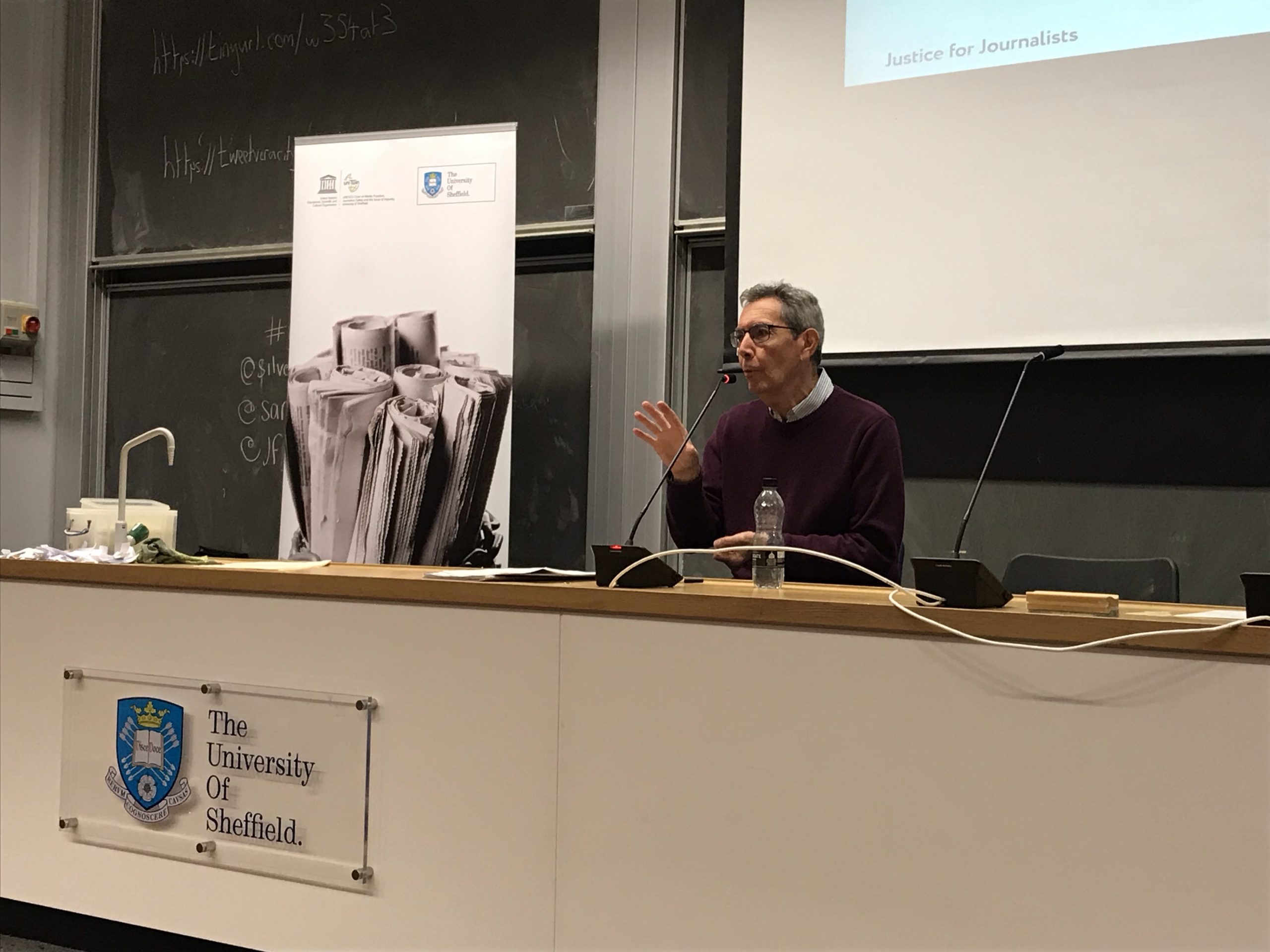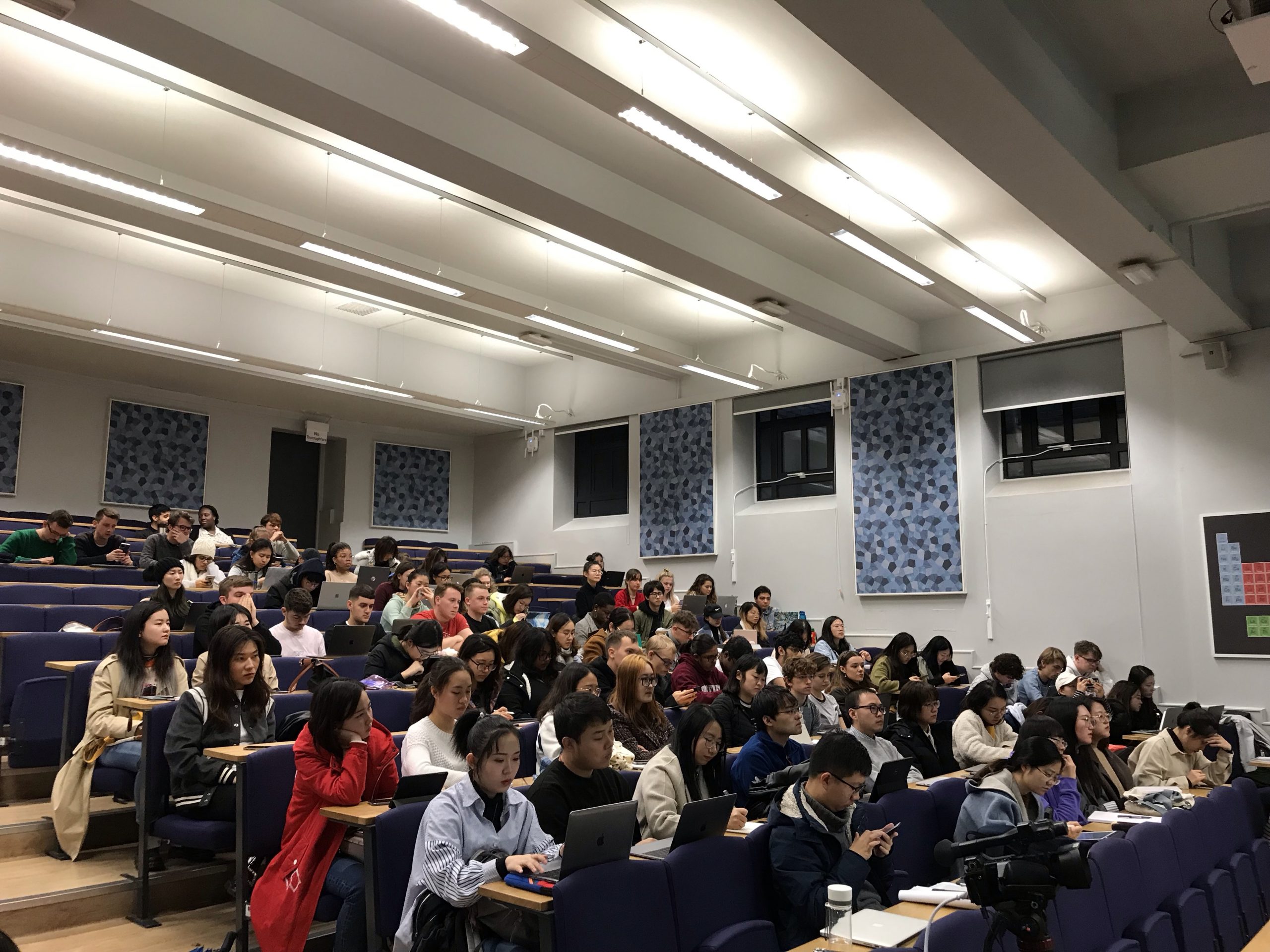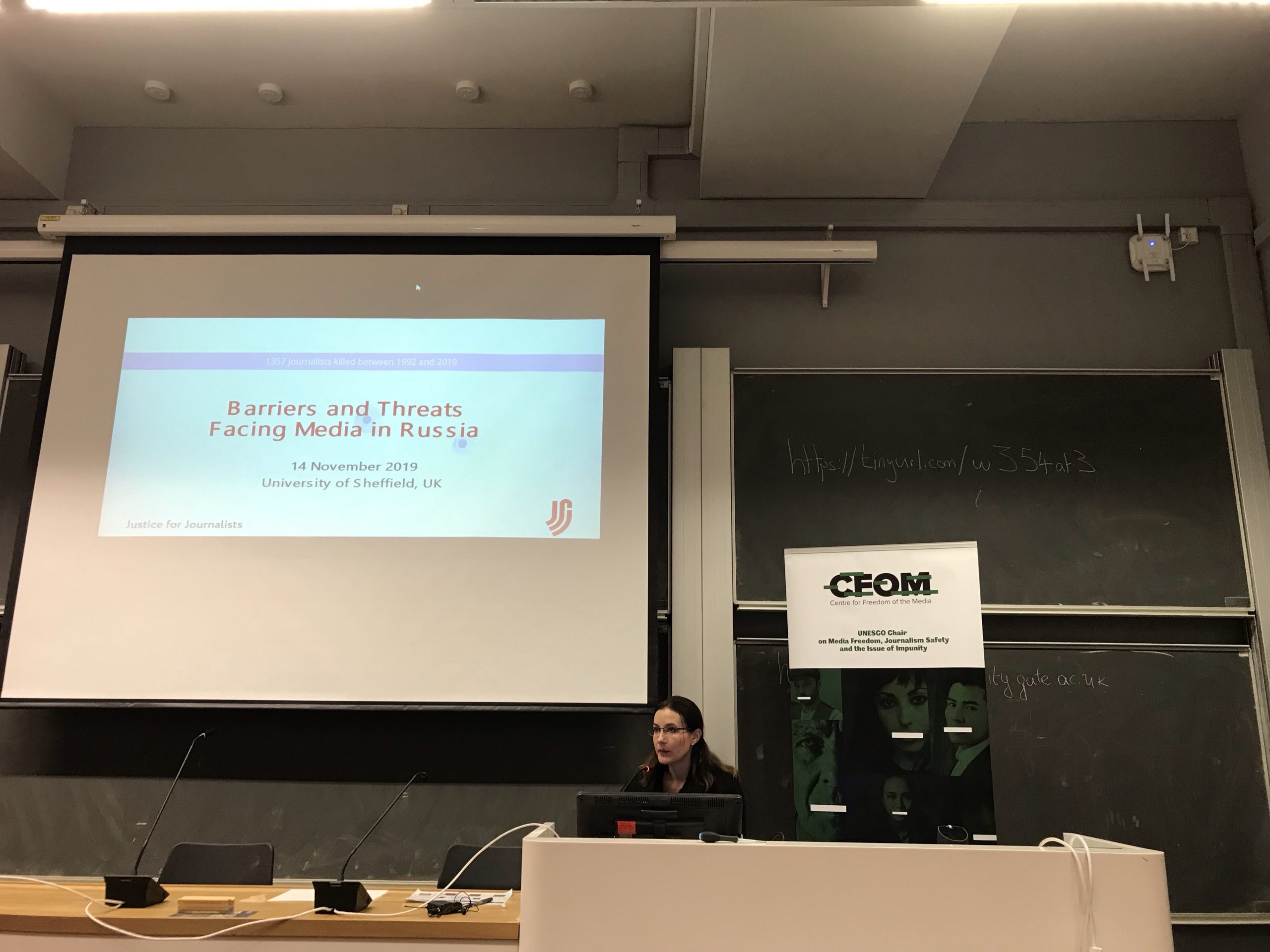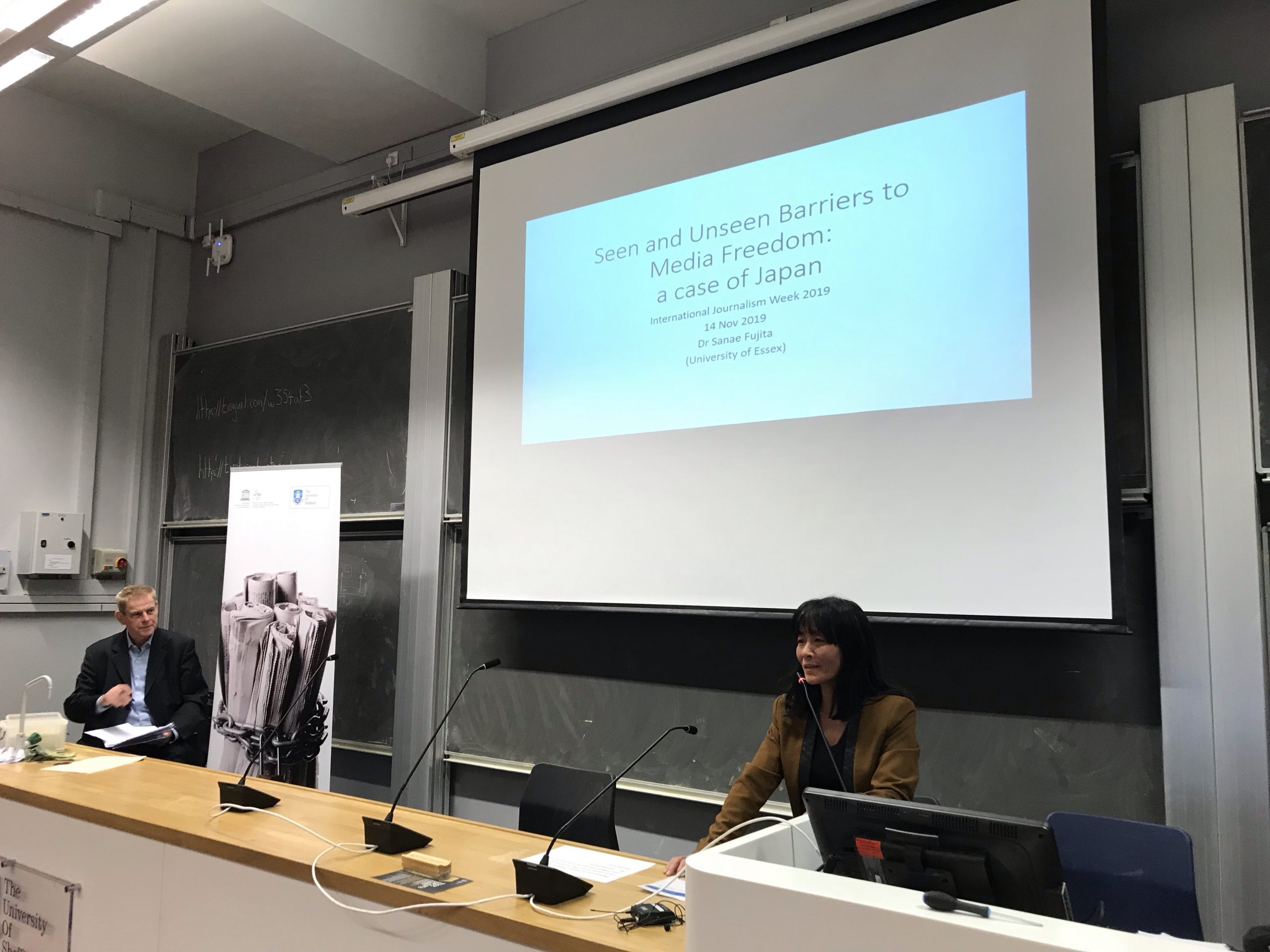By Michael Quinn and William Horsley
The CFOM Panel session, moderated by CFOM International Director William Horsley, was flagged as an event marking International Day to End Impunity for Crimes against Journalists. The session was organised under the auspices of the UNESCO Chair in Media Freedom, Safety of Journalists and the Issue of impunity in the presence of the Chairholder, Professor Jackie Harrison, who heads the Department of Journalism Studies.
University of Sheffield undergraduate and postgraduate Journalism Studies students gained insights into the multiple forms of visible and often unseen barriers in real-life environments that have the effect of shielding government authorities from scrutiny and accountability, which in some cases have led to climates of impunity. The three speakers made presentations describing barriers and forms of arbitrary government behaviour that materially restrict the ability of journalists to report freely and without fear of reprisals in the widely different environments of the UK, West Africa, Russia and Japan.
Students also attended a separate talk arranged by CFOM in which Richard Danbury, a specialist practitioner and teacher of investigative journalism skills, spoke about the “rules of the game” in investigative journalism.

Jon Silverman, Professor of Media and Criminal Justice at the University of Bedfordshire and a former award-winning BBC Home Affairs correspondent, described how in recent years the practice of journalism in the UK has been constrained by the enactment of a series of new and restrictive laws. Among the most important of those are the Regulation of Investigatory Powers (RIPA) Act, the 2000 Terrorism Act and the various iterations of the Official Secrets Act.
The Investigatory Powers Act has been criticised by journalists and free expression organisations as the “Snoopers Charter”. “Obtaining and communicating information is the lifeblood of journalism”, Jon said, and this legislation had threatened some of the vital protections that should be guaranteed to whistle-blowers, journalists, and their sources.
He cited the fact that in 2015, the Interception of Communications Commissioner disclosed that, in the previous three years, the RIPA act had been used against 82 journalists in order to view their phone records and identify confidential sources. This helps explain why the UK had sunk to 33rd out of 180 countries in the Press Freedom Index published by Reporters Without Borders.
Jon also expressed deep concern about the evidence that cases of physical intimidation of journalists have increased. Guardian columnist Owen Jones had been attacked by extreme right-wingers and other journalists had been targeted at the trial of the far right English nationalist Tommy Robinson. Jon argues that the issue of the physical safety of journalists, even in the UK, has become more worrying. There is now a real danger of journalists being seriously injured or even killed. And this trend is mirrored by the growth of angry rhetoric and behaviour in everyday politics which in 2016 led to the shocking murder of the Labour MP Jo Cox during the EU referendum campaign.
Professor Silverman also shared some reflections on his close knowledge of the evolving situation for the media in the West African state of Sierra Leone. In that country, during the civil war of the 1990s, journalists had suffered violent repression and were constantly ‘under fire’. A national newspaper editor had been murdered together with four of his children. These days, he said, it is generally the law that is used to curb independent journalism. Sierra Leone is one of several African countries which still maintain harsh laws left over from colonial times on criminal defamation and ‘seditious libel’, which are still being used to intimidate or arrest journalists.
Jon also pointed to structural obstacles to worthwhile free journalism in parts of Africa. The first is poverty: in most sub-Saharan countries, Jon said, journalists are so poorly paid that they require reimbursement, in some form, from public figures who want their press conferences to be reported by the media. Secondly, journalists often identify closely with politicians of their own ethnic group. This leads to open partisanship by journalists and a relationship of patronage and effective ‘media capture’ by political forces. Even so, a good many journalists who work in such difficult circumstances have a genuine passion for holding governments to account. One of them is Sorious Somora, a courageous investigative journalist who has won several awards for his reporting of corruption in Africa.

Maria Ordzhonikidze is Director of the Justice for Journalists Foundation, a London-based NGO based in London that funds journalistic investigations into violent crimes against media workers and raises risk preparedness among professional and citizen journalists by facilitating journalists’ access to educational resources. We promote the importance of safety and monitor threats media workers face on the daily basis.
Maria summarised the repressive conditions in which Russian journalists have to work as ‘a political monopoly with no judicial independence’, ruled in an authoritarian, top-down structure by President Putin and a tight circle of so-called ‘siloviki’ or power brokers from the former Soviet KGB, the army, and the defence and security industries.
President Putin’s circle relies in large part for its 20-year long dominance of Russian state structures on its near monopoly of control over television, by far the most influential form of mass media. All ten of the most watched TV channels are controlled directly or indirectly by the Kremlin, she said. A mountain of oppressive legislation has the effect of criminalising the work of journalism in a variety of ways. NGOs, media and and individual media workers that receive foreign funding are obliged to register as ‘foreign agents’ and draconian extremism laws are routinely used to curb free speech. Only certain online and social media remain relatively free to express dissent and command a substantial following among ordinary Russians. But already sweeping and repressive legislation allows the authorities to close down websites without the normal judicial safeguards, and further harsh laws are being planned to bring the online world under the Kremlin’s sway as well.
The most striking part of Mrs Ordzhonikidze’s presentation concerned the very high estimates for the number of recorded killings and other violent attacks against journalists in Russia. She cited figures gathered by the Glasnost Defense Foundation stating that as many as 170 journalists lost their lives in connection with their work in Russia between 2000 and 2019 and a further seven have ‘disappeared’ without trace. . Blatant political controls over the judiciary in Russia allow impunity to become the norm in cases involving the killings of journalists, with over 90 percent of all cases remaining unresolved even after many years.

Justice For Journalists’ own assessment, using reliable open sources, concludes that between 2017 and September 2019 14 journalists or media workers met violent deaths in Russia. And in that time JFJ identified 435 separate attacks or threats – including cyber attacks and targeted legal and economic measures — against journalists or media.
Details of JFJ’s findings and analysis on Russia and the Former Soviet Union are accessible on the Justice for Journalists website.
The restrictions on media expression extend beyond censorship, with journalists vulnerable to arbitrary detention, prosecution and surveillance by state authorities, often without any credible recourse to the law to protect them. Maria drew attention to the imprisonment of a number of journalists after the state had falsified legal cases against them. In Russia, she asserted, the state uses fakes of different type, including spreading disinformation and deep fakes, as “a weapon of choice against journalists”.
A rare victory in the fight against the arbitrary exercise of state power and impunity occurred in June this year, when public outrage forced Russia’s interior minister to admit that criminal drugs charges against investigative journalist and anti-corruption campaigner Ivan Golunov had been falsified in an attempt to frame him. The charges were dropped and it was announced that the officials responsible would be dismissed. The case highlighted the potential weakness of authoritarian governments when faced with powerful public opposition to corrupt practices and to attempts by state officials to put themselves above the law.
Click here for the slide presentation by Maria Ordzhonikidze on ‘Barriers and Threats Facing Media in Russia’.
Dr Sanae Fujita, a Fellow at Essex University’s Human Rights Centre, by contrast, drew on her in-depth research to portray Japan as a country where mainstream media are largely made docile and compliant with government authority — not by strong-arm methods or formal censorship but by means of subtle pressures and elaborate controls on the flow of information that often result in self-censorship.
She pointed to a worrying trend of the degradation of media in Japan over the last decade. In 2010 the country had been placed in a respectable 11th place in Reporters Without
Borders’ Press Freedom index in 2010, but thanks to a long period under the very conservative leadership of Prime Minister Shinzo Abe Japan had sunk to 67th place in 2019.

The roots of the tradition of compliant media are very deep, as Dr Fujita explained.
The unique system based on newsgathering through a nation-wide network of so-called “kisha clubs” dates back to 1890. The system involves journalists from favoured mainstream media titles inhabiting premises inside every significant governmental or economic institution in the country and feeding off the regular briefings and press conferences of the officials there. At the start the system was meant to allow the press to get closer to political power so as to hold it accountable. But in the pre-war period and during the Second World War the system was exploited as a subservient tool of government propaganda. And in the post-war years the kisha clubs have often served to protect the powerful from scrutiny of their mistakes, cover-ups and frequent corruption scandals. The system has become notorious abroad for excluding small, alternative media and foreign journalists.
In addition, the absence of an independent system of regulation for broadcasting has allowed the government to pressure the national broadcaster, NHK, into what is now widely seen as a major partisan player on the side of the government. In recent years three prominent and critical Japanese TV anchors were dismissed apparently after informal pressures were applied to their employers. And the submissiveness of kisha clubs to the private interests of the prime minister himself became apparent when a major scandal implicating Mr Abe in cronyism over the sale of public land on favourable terms to a right-wing political ally failed to bring the government down. Instead the falsification of documents by senior officials to protect the powerful was downplayed by pliant national media and the scandal blew over, leaving Mr Abe further strengthened and increasingly hostile to critical media.
Sanae referred to her own activities in support of the UN Special Rapporteur on Freedom of Expression, David Kaye, who after a visit to Japan in 2016 warned the UN Human Rights Council about what he said were serious threats to media independence arising from stringent secrecy laws and the cosy kisha club system inhibiting the proper ‘public watchdog’ role of the news media. In 2019 he issued a highly critical follow-up report in which he regretted the failure of the Japanese government to act on his recommendation to review the legal framework governing broadcast media. He also stated that the authorities had contravened his call to stop attempts to intimidate critical journalists; instead he cited fresh reports of officials putting pressure on and issuing public statements against critical media outlets.
You can view Sanae’s presentation slides here.

